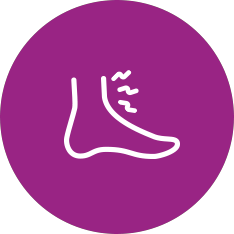Achilles Tendinopathy
What is Achilles Tendinopathy?
Achilles tendinopathy is a common condition that affects the tendon that connects your calf muscles to your heel bone (calcaneus).
The achilles tendon is incredibly strong and allows you to push your body weight onto your tiptoes. When we walk it takes a lot of stress as we are repeatedly going from heel to lifting on to our toes with each step.
Sometimes due to increased or abnormal stress/load to the tendon, it can become painful and lead to swelling and stiffness.
What are the symptoms?
- Pain around the back of the heel or above – this can vary from mild to severe
- Swollen or thickened tendon at the back of the ankle. Sometimes there is a red lump.
- Stiffness felt in the tendon first thing in the morning or after periods of rest
What are the causes?
The exact cause is not always known, but typically occurs when a tendon is unable to cope with the strain placed upon it. There are also many factors that can increase your risk:
- Sudden change to normal activity levels such as: running more or in different shoes, doing a charity walk, walking in flop-flops on holiday
- Repetitive activities that continually overload the calf and achilles tendon
- Fall or injury to achilles tendon
- Inactivity causing deconditioning of the muscles and tendons
- Being older (over 30)
- Smoking
- Being overweight
- Diabetes
For more information to help support your general health and well-being, please click here to access our "Healthy You" page. This includes information on exercise, mental health, smoking and weight management.
How long will it last?
Everyone's pain is different and full recovery can depend on multiple factors, but most people will make a full recovery. Most people will see some improvement following 12 weeks of lifestyle changes, advice, and an exercise program. Tendon healing can be a slow process and can take up to 18-24 months to fully resolve.
What can I do to help myself?

What else can I do?
A gradual increase in load once its less inflamed can help the tendon improve. We have provided some exercises in the links below. Start with the easiest and build up to the more advanced exercises as you feel able to.
Easy exercises for Achilles Tendinopathy
Moderate exercises for Achilles Tendinopathy
Advanced exercises for Achilles Tendinopathy
Do I need an x-ray or a scan?
In most cases, no. A good history and physical examination alone provides enough information to diagnose your problem. Scans and x-rays are not always useful for diagnosing achilles tendinopathy. While a scan or x-ray may provide information it rarely alters the treatment plan.
Imaging findings are very poorly linked with pain and often people with no pain have very similar findings on their scans/x-rays to those that do. X-rays and scans can help for a small number of people in certain situations and will be recommended by a healthcare professional if required.
Symptoms to check
Click the plus sign to see a list of problems that could be a sign you may need to be checked urgently
Get advice from 111 now if:
- your ankle is very painful and you cannot put any weight on it
- you have direct injury to the ankle and it has become very swollen very quickly
- your ankle is badly swollen or has changed shape
- you heard a snap, grinding or popping noise at the time of injury
- you have a very high temperature, feel hot and shivery, and have redness or heat around the ankle – this can be a sign of infection
111 will tell you what to do. They can tell you the right place to get help if you need to see someone.
Go to 111.nhs.uk or call 111.
Immediate medical advice is available by contacting NHS 111


 Ankle
Ankle